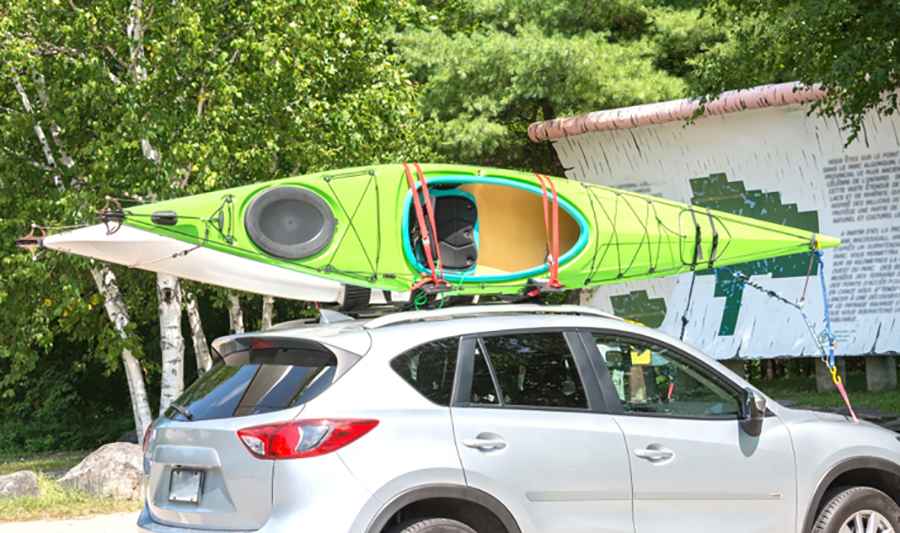How to Transport a Kayak Safely (Especially on Dangerous Roads)
While hard-sided kayaks are much better than inflatable kayaks in many aspects (namely speed, maneuverability, and price), they do have a downside.

Yes, that’s right. Transportation.
And if you pair an improperly secured kayak with dangerous, narrow roads, you get a recipe for catastrophe.
So, in this article, we’ll teach you all there is to know about how to transport a kayak in the safest way possible.
And don’t worry, it won’t take hours either!
Once you get the hang of it, car-topping your kayak and securing it takes around 5 to 10 minutes.
Kayak Transportation Essentials
Secure and Adequate Roof Rack
First things first. When it comes to transporting a kayak, you need a sturdy roof rack. Make sure your roof rack is designed for carrying watercraft and properly secured to your vehicle. Avoid anything that feels unstable or cheap.
I personally use a Yakima J-cradle with a Vault crossbar and that allows me to carry my kayak without any issues. You don’t have to get the exact same gear, but you should know that a good setup should cost you $150 or more, even if you have a budget kayak. Otherwise, it won’t be good enough.
Use Quality Straps
Once you have your roof rack, you need to invest in high-quality kayak straps that are durable and reliable. These straps will keep your kayak firmly attached to the roof rack. Tighten them securely to prevent any wobbling or shifting during transportation.
The good news is that good straps generally cost around $10 or $20, so there’s no reason to skimp on quality here.
Positioning Matters
Properly position your kayak on the roof rack. The front of the kayak should face forward, with the cockpit facing the rear of your vehicle. This minimizes wind resistance and improves stability.
Additionally, if you have a long touring kayak, make sure that it’s properly centered and doesn’t stick out the back too much.
Bonus tip: Protect with Padding
As an extra measure, you can place foam or cushioning pads on the roof rack's crossbars. This prevents scratches and damage to your kayak's hull during transit.
While this is completely overkill for plastic kayaks, it can be extremely important for carbon fiber or even fiberglass kayaks.
Navigating Challenging Roads
Slow and Steady
On bumpy or dangerous roads, maintain a steady and moderate speed. This reduces the risk of sudden jolts or shocks that could damage your kayak.
For instance, there are many narrow and winding roads where I live. While other people tend to accelerate and brake all the time, I just maintain a low, constant speed. Sure, this might not be as fun, but it will be infinitely safer.
Monitor Weather Conditions
This may seem obvious, but you should keep an eye on the weather forecast, especially when you plan to transport your kayak. Avoid traveling during extreme weather conditions that could make roads even more treacherous.
I’ve personally had to cancel kayaking trips more than once due to poor weather, and yet I’m no beginner. The truth is that the more experienced you are, the more you know that it’s better to be overcautious than overzealous.
Safety Measures
Double (and Triple) Check Straps
Before hitting the road, double-check the straps to ensure they're still secure. Straps may loosen during transit, so it's essential to verify their tightness.
When I first started transporting my kayak, I made the mistake of not double-checking the straps before hitting the road. As a result, one of the straps loosened during transit and my kayak started to shift. Luckily, I was able to pull over and tighten the strap before any damage was done.
Use Red Or White Flags
Attach red flags to the ends of your kayak, extending beyond the vehicle's width. This enhances visibility to other drivers, reducing the risk of accidents.
If you don’t have a red flag, you could attach a white cloth or similar. Just make sure it’s big enough to be seen, and avoid dark colors that wouldn’t be seen at night.
Regular Inspections
On long road trips, it’s recommended to make regular stops to inspect the kayak's positioning and the straps' tightness. It's better to catch and address any issues early to prevent potential disasters.
How to Car Top a Kayak - FAQ
How can I prevent my kayak from scratching during transportation?
Use padding on the roof rack crossbars and ensure the kayak is properly positioned to avoid contact with the vehicle. This is especially important for carbon fiber kayaks, and even for fiberglass kayaks.
What is the optimal speed for transporting a kayak on challenging roads?
Maintain a moderate and steady speed to minimize the risk of sudden jolts or shocks. If too many cars start piling up behind you, just find a good spot to park and let them pass.
Why is it essential to use red flags when transporting a kayak?
The truth is that most kayaks will stick out at the back of the vehicle. If you don’t attach red flags or a white cloth at the back, the car behind you might get too close to you and hit the kayak.
How to Transport a Kayak - Conclusion
It’s true, transporting a kayak can be annoying.
That’s why inflatable and foldable kayaks have become so popular.
However, it’s also true that with a bit of practice (and with the proper gear), this can be done in under 10 minutes.
By following the tips in this article, you can safely transport your kayak, even on dangerous roads.
Image credit: Depositphotos